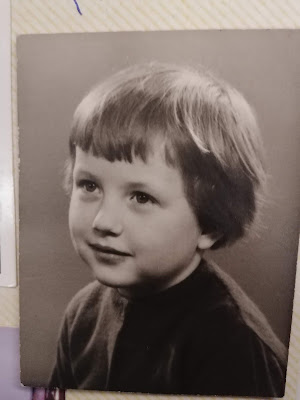Please scroll down for the English version!
Written by Dorikri
Post precedente - Previous post
Entriamo in una sala sopra e uguale a quella con i due camini precedente.
Al posto di uno dei due camini si trova il primo quadro:
"Vi ricordate che Maurizio vi ha detto che il suo quadro preferito era il più grande che c'era qui al museo? Eccolo! Secondo voi perchè gli piace tanto?" Tutti insieme e urlanti "Perchè sono degli animali come lui!!"
Effettivamente questo immenso quadro -"Il toro" di Paulus Potter 1647- , rappresenta una campagna con un grande albero all' ombra del quale si ripara un toro e le sue mucche.
Attorno si possono vedere tutta una serie di animali.
E qui comincia la "lezione": fatti sedere per terra, a turno gli si chiede di guardare bene e di enunciare tutti gli animali, di chiamarli con il nome corretto, di parlare dei colori, delle ombre, quale è più grande quale più piccolo, le posizioni di ognuno ecc...ecc...
"Poi si passa al gioco della prospettiva: la guida tira fuori da un borsone tanti pezzi di legno che rappresentano i vari animali, insetti, e flora.
Deposita a terra davanti a loro un pezzo di legno con delle scanalature nel senso della lunghezza e porge ad ogni bambino un elemento del quadro e gli chiede di sistemarlo nella scanalatura che gli sembra più giusta.
L'ultimo legno è...lo sterco del toro!
La guida si tappa il naso e chiede chi vuole posizionarlo sul legno...
Alla fine, davanti questo, dietro quest'altro, spostato a sinistra o a destra... il quadro viene ricostituito!
C'è un miglior modo per spiegare la prospettiva a dei bambini di 3-4 anni?
E vi assicuro che l'hanno capita tutti quanti!!
Written by Dorikri
Post precedente - Previous post
Entriamo in una sala sopra e uguale a quella con i due camini precedente.
Al posto di uno dei due camini si trova il primo quadro:
"Vi ricordate che Maurizio vi ha detto che il suo quadro preferito era il più grande che c'era qui al museo? Eccolo! Secondo voi perchè gli piace tanto?" Tutti insieme e urlanti "Perchè sono degli animali come lui!!"
Effettivamente questo immenso quadro -"Il toro" di Paulus Potter 1647- , rappresenta una campagna con un grande albero all' ombra del quale si ripara un toro e le sue mucche.
Attorno si possono vedere tutta una serie di animali.
E qui comincia la "lezione": fatti sedere per terra, a turno gli si chiede di guardare bene e di enunciare tutti gli animali, di chiamarli con il nome corretto, di parlare dei colori, delle ombre, quale è più grande quale più piccolo, le posizioni di ognuno ecc...ecc...
"Poi si passa al gioco della prospettiva: la guida tira fuori da un borsone tanti pezzi di legno che rappresentano i vari animali, insetti, e flora.
Deposita a terra davanti a loro un pezzo di legno con delle scanalature nel senso della lunghezza e porge ad ogni bambino un elemento del quadro e gli chiede di sistemarlo nella scanalatura che gli sembra più giusta.
L'ultimo legno è...lo sterco del toro!
La guida si tappa il naso e chiede chi vuole posizionarlo sul legno...
Alla fine, davanti questo, dietro quest'altro, spostato a sinistra o a destra... il quadro viene ricostituito!
C'è un miglior modo per spiegare la prospettiva a dei bambini di 3-4 anni?
E vi assicuro che l'hanno capita tutti quanti!!
We enter a room which looks the same as the previous one with the two fireplaces.
Here, instead of a fireplace, there is a huge painting:
-"Do you remember that Maurits told you that his favorite painting was the largest in this museum? Here it is! Why do you think he likes it so much?"
All the kids answer screaming together:
-"Because there are animals like him !!"
In fact, this immense painting - "The bull" by Paulus Potter 1647-, represents the countryside with a large tree offering shade to a bull and its cows.
Around them, there are several different small and big animals and insects. And here begins the "lesson": the guide gets the children to sit on the ground; in turn, they are asked to look carefully and with attention to the details and to enunciate all the animals, to call them with their correct names, to talk about the colors, the shadows, which one is bigger which smaller, the positions of each one, etc. .etc ...
Then we move on to the perspective game.
The guide pulls out of a bag many pieces of wood representing the animals, insects, and flora.
She places, on the ground, in front of the children, a flat piece of wood with grooves lengthwise and hands over to each child an element of the painting and asking him/her to place it in the groove they consider most appropriate.
In the front or in the back, in front of this or behind that, maybe behind this other one? Move it more to the left or to the right... and finally: there is the painting!
Is there a better way to explain perspective to 3-4 years old children?
And I assure you that everyone understood it perfectly!!













